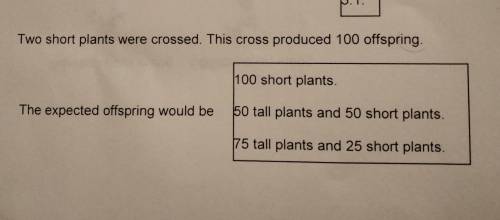Please help its science
...

Biology, 13.12.2021 23:40 shayleithomas
Please help its science


Answers: 2


Other questions on the subject: Biology


Biology, 21.06.2019 20:30, alevans7144
For your initial isolation of the bacterium, you simply needed to grow enough of it that you could identify some of its more general features. thus, you used a complex nutrient agar that would allow for the growth of almost any bacterial species. different bacterial species often have very specific requirements for life. this is a fact that you can utilize when you are trying to identify the bacterium to the species level. growth conditions that will permit the growth of one species but not another may allow you to select which one you would like to culture. you can utilize different selective/differential media that allow for the growth of only one type of bacteria (e. g., either gram positive or gram negative). culturing media such as phenylethyl alcohol or sodium chloride agar will be selective/differential for gram-positive bacteria. you may also want to show that it is different from other bacteria that may be present, so you could use a selective/differential agar. selective/differential media such as blood agar or phenol red sugar broths allow for the determination of whether a bacterial cell can grow and utilize specific ingredients included in the medium and turn the agar a distinct color. sheep's blood agar utilizes red blood cells to differentiate which bacterial species may have hemolytic properties. selective or differential? 1. an agar that uses a high salt concentration to limit the growth of one type of bacteria over another would be considered selective/differential. 2. if an agar contains a dye or ph indicator in the presence of a sugar, it is generally considered selective/differential for those bacteria that may ferment the sugar over those that cannot. 3. an agar that uses the dye in crystal violet agar suppresses the growth of gram-positive bacteria. this agar would be considered selective/differential. 4. the selective/differential aspect of macconkey agar allows for the determination of which bacteria are lactose fermenters and which are not. 5. a blood agar plate contains sheep red blood cells and allows for the determination of hemolytic capabilities for all bacteria that grow on the agar. this would make this type of agar selective/differential. 6. emb agar uses lactose and two dyes that allow it to be selective/differential between the blue-black colonies of e. coli and the pinkish colonies of all other enteric bacteria. 7. bile salts in macconkey agar allow for the agar to be selective/differential for the growth of enteric gram-negative bacteria over gram-positive bacteria. 8. an agar that allows for the distinction of bacteria based on metabolism would be considered selective/differential.
Answers: 1

Biology, 22.06.2019 01:00, stodd9503
If water were a non polar molecule, how would its properties be different ? a.) water would be a much lighter molecule b.) water would be able to climb up inside plants c.)water would not be able to form hydrogen bonds d.) water would stick together much more strongly
Answers: 2

Biology, 22.06.2019 05:30, awesome266
This map shows how climate change might affect precipitation patterns in the great plains of the united states by the end of this century. brown shoes a decrease in percipitation, and blue shows an increase. the maps differ based on the predictive levels of green house emissions. the maps shows that northern area should get a. more pracipations regardless of emmissions b. less pracipation, regardless of emmissions levels c. more precipitation, but only when emission levels. southern areas show a. more pracipations regardless of emmissions b. less pracipation, regardless of emmissions levels c. more precipitation, but only when emission levels. to use these maps to prepare for natural disasters in the great plains, scientist need to ask? a. how many tons of emissions were used at the basis of the map. b. which types of fossil fuels are used in the great plains c. if you think the above is wrong it's probly c the question is cut off
Answers: 1
You know the right answer?
Questions in other subjects:





Computers and Technology, 23.09.2020 22:01


Chemistry, 23.09.2020 22:01

Mathematics, 23.09.2020 23:01


English, 23.09.2020 23:01



